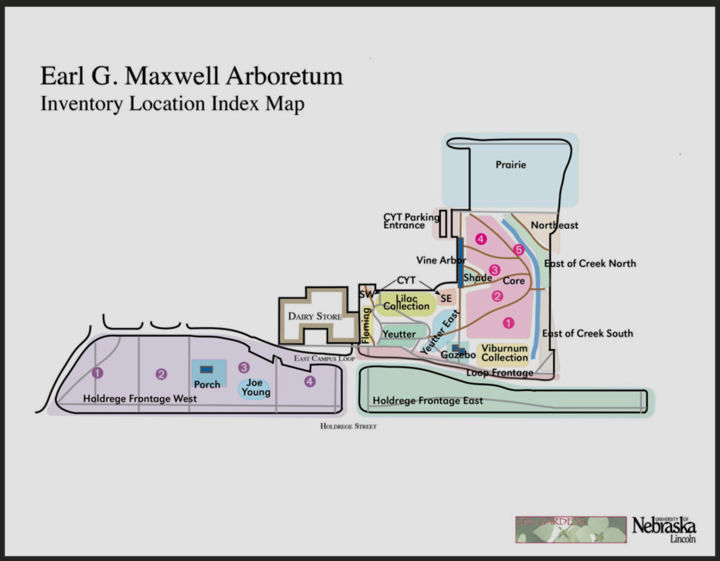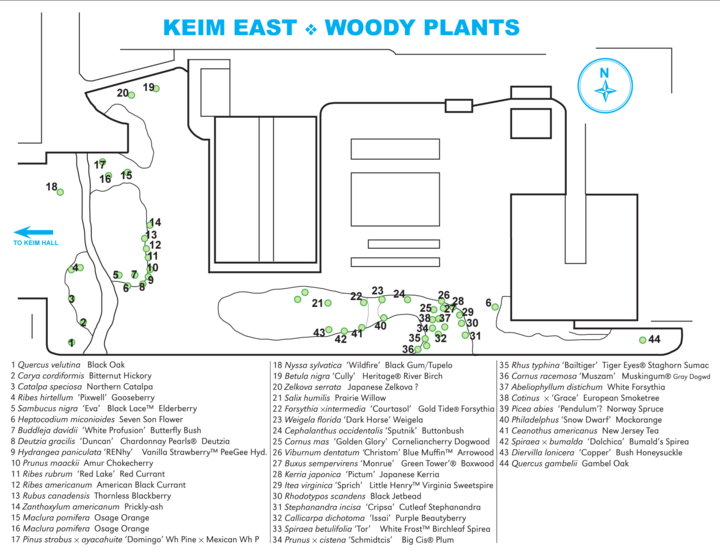UNL Gardens
"Youth is like spring, an over-praised season more remarkable for biting winds than genial breezes.
Autumn is the mellower season, and what we lose in flowers we more than gain in fruits."
- Samuel Butler
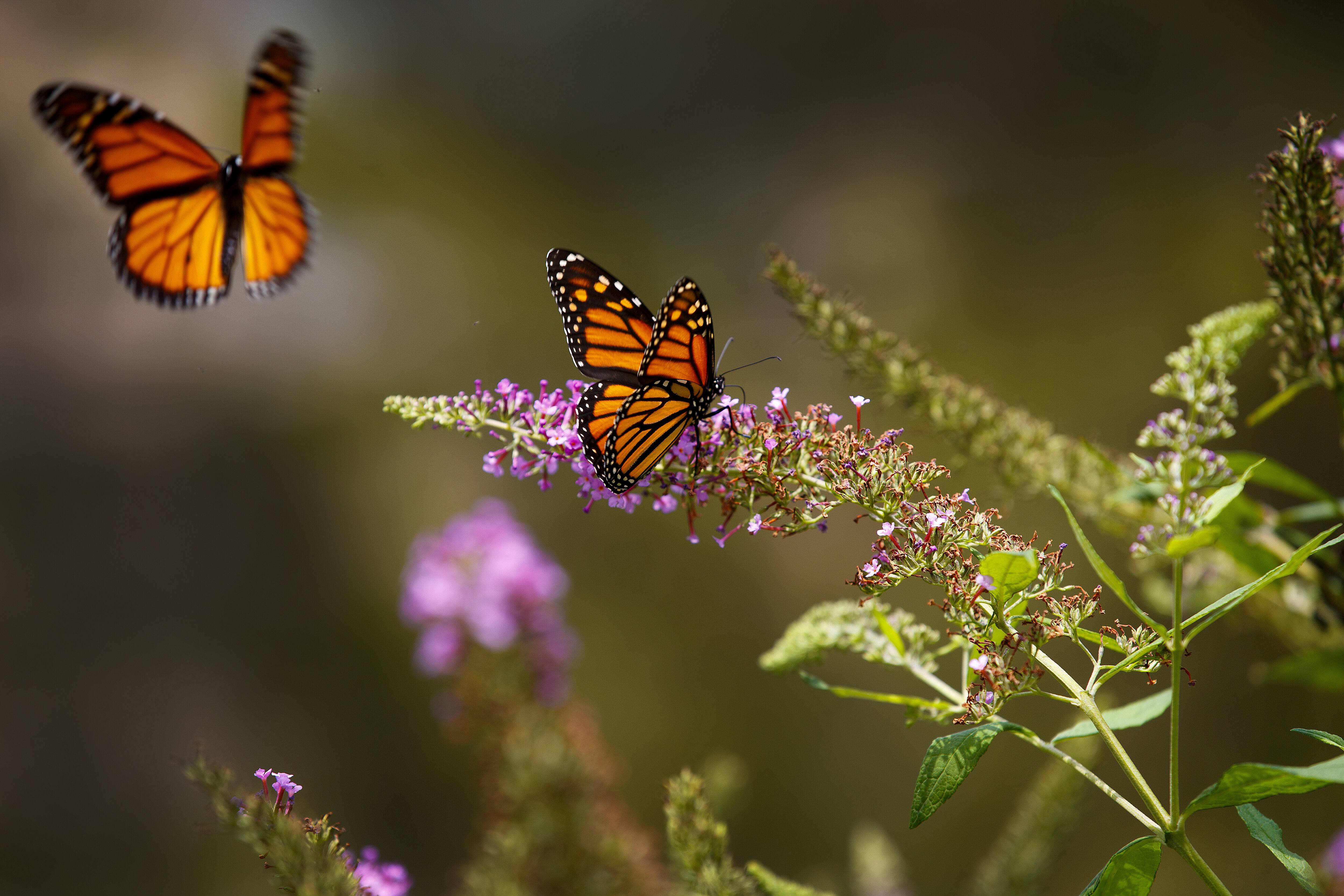
UNL Gardens: A Beautiful Way to Learn!
We are dedicated to the proposition that the living horticultural resources of the University of Nebraska – Lincoln's East Campus are not only places to enjoy aesthetically, they are an invaluable educational tool, a place to reflect on life; they are an often overlooked jewel in the crown of Lincoln's greenspaces.
UNL Gardens is supported by the IANR Vice Chancellor's office with help from the Friends of Maxwell Arboretum and is housed in the Community Forestry and Sustainable Landscape Program of the NFS.
Why on earth, you might ask, does the world need another plant website? There are surely enough by now. While it is true that there are plenty of excellent sites where you can access information about plants, we hope ours will present some major differences. First, we are concerned primarily with the specific plants found on East Campus; our information will act as a guide to those visiting campus and a resource for those who cannot. Secondly, we believe in the principal put forth by Elizabeth Lawrence: "Gardening, reading about gardening, and writing about gardening are all one; no one can garden alone" (The Little Bulbs: A Tale of Two Gardens, 1957).
You'll find lots of horticultural "read more about it" here, with a special emphasis on historical resources. We aim as well, to link the horticultural world to the greater world of ideas, to literature, philosophy, history, politics, and poetry. If gardening were just about the plants it would be a great thing; the fact that it connects us to an experience of the wider world is what imbues it with meaning and makes it a sustaining force in our lives. In addition to material on the gardens of East Campus, we will present information on the horticultural history of the campus, published resources on horticulture of the Great Plains from the past 140 years, and links to other great websites to enrich your gardening experience and love of plants.
See you in the gardens,
Emily Levine
University of Nebraska – Lincoln
Earl G. Maxwell Arboretum
Arboretum Map
History of Maxwell Arboretum
The Earl G. Maxwell Arboretum: 55 Years of Legacy and Growth
The Earl G. Maxwell Arboretum is a treasure of horticultural beauty, shaped by decades of vision, dedication, and hard work. From the majestic oaks and lindens to prairie grasses glowing in fall, its beauty lies in both sweeping vistas and intricate details—buds breaking, fruits ripening, and pollinators at work. Serving as an educational resource, a retreat, and a jewel of Lincoln's gardens, the Arboretum embodies nature’s poetry.
Earl G. Maxwell, a native of Indiana and a University of Nebraska graduate, began planting trees here 80 years ago. As the State Extension Forester, he championed Nebraska's shelterbelts and planted over 100 species at the site, trialing hardy plants for the state's harsh climate. His passion for forestry and poetry left a lasting legacy, officially honored in 1967 when the University designated the area as the Earl G. Maxwell Arboretum.
Over the decades, the Arboretum has flourished through community efforts, including contributions from students, faculty, and organizations like the Garden Club of Lincoln. Major milestones include the dedication in 1969, the addition of diverse plant collections, and the establishment of educational features like the Vine Arbor and Karl Loerch Gazebo. The 1970s saw the creation of native prairies and the integration of the Arboretum into the Nebraska Statewide Arboretum, solidifying its role in education and conservation.
Significant growth continued through the 1980s and 1990s with improved maintenance, new plantings, and the development of features like the Perin Porch and Fleming Slope. Events like the Gardeners’ Gala brought the community together to celebrate horticulture, even as storms like the 1997 blizzard tested its resilience.
Today, the Arboretum is a place of learning, reflection, and community celebration, hosting seasonal events and providing resources like online plant inventories and interactive signage. As we honor its 50th anniversary, we thank those who nurtured this vibrant space and look forward to the next fifty years of growth and discovery.
The Maxwell Arboretum invites all—whether for quiet reflection, family photos, or springtime lilacs—to experience the enduring connection between people and nature.
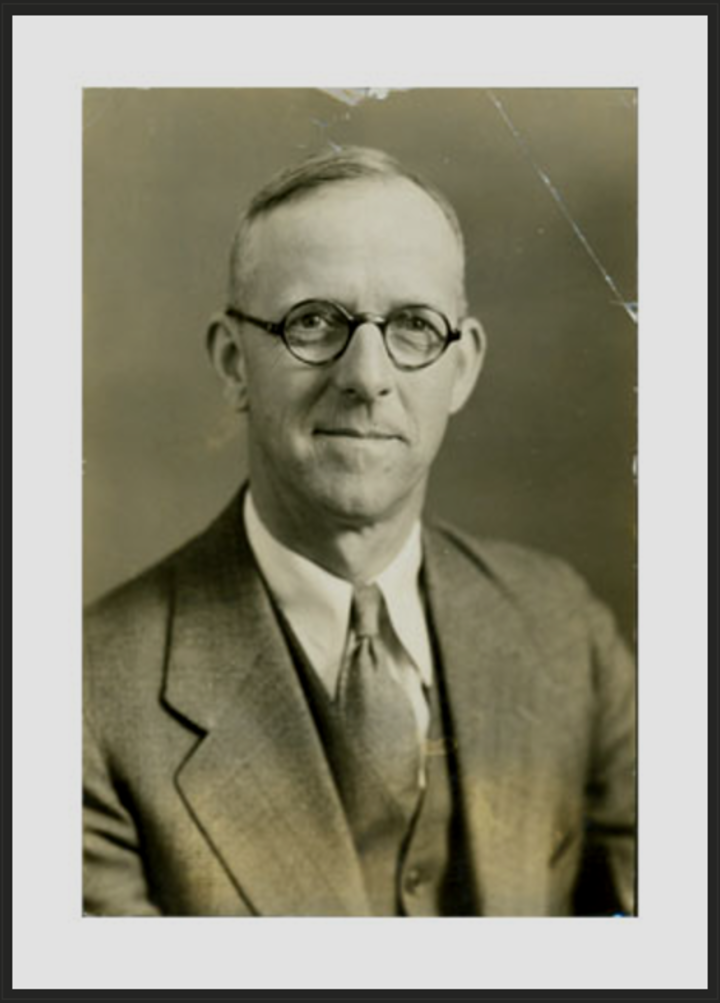
Bloom Time Chart
The Bloom Time Chart contains information collected between 2005 to 2022 for standard plants that can be found in Arboretum locations on this map.
Own Time/Any Time Tour
The “Own Time, Any Time” cell phone tour of the Earl G. Maxwell Arboretum is the result of the master’s project of horticulture student Elizabeth Killinger. A native of Cotesfield, Nebraska, Killinger received her undergraduate degree in horticulture from UNL. Working under associate professor Kim Todd, Killinger used voice mail technology to create the tour, which guides visitors to points of interest in the arboretum. Users dial a general access number and, from there, are guided through a series of options. Currently, there are five stops and two information numbers on the tour, but there are plans for expansion, as the possibilities with this technology are virtually limitless. Tour brochures with maps are available at the East Campus Visitor’s Center, located in the Dairy Store.
Killinger writes, “Visitors coming to East Campus for an ice cream cone or to enjoy the fall colors may not be aware of the international links between a particular plant and history or the diversity of learning opportunities available. These little-known bits of information provide a layer of interest and intrigue, personalizing and connecting what is often perceived as a vast institution to real people and real events.”
The tour emphasizes history by including information on giants in the field of plant sciences at the university, such as Charles Bessey, John E. Weaver, George Beadle and Earl Maxwell, himself. There are tour stops about specific plants, gardens and collections, including Fleming Slope and the three plant breeding brothers for which it is named, the design principals used in creating Yeutter Garden and the history and lore of lilacs. The tour’s information numbers lead you to the ReTree Nebraska Program and the Big Red Green Team.
There are also numbers at which you can leave feedback and find out what is new and different. The number to access the tour is (402)472–5555.
—Nebraska Green Scene, An Annual Publican of UN-L's Department of Agronomy and Horticulture, 2008
Friends of Maxwell Arboretum
Join the Friends of Maxwell Arboretum
The Earl G. Maxwell Arboretum on the University of Nebraska–Lincoln's East Campus is a jewel in the crown of Lincoln's green spaces. Honoring the legacy of State Extension Forester Earl Maxwell who began planting trees for evaluation in this location, the Arboretum was formally dedicated on June 8, 1969 following action by the Board of Regents two years earlier. A flagship site of the Nebraska Statewide Arboretum, its twelve acres provide access to a wide variety of trees, shrubs, vines, and herbaceous perennials, both as single specimens and in genus collections.
Over the years, numerous individuals, academic departments, and civic organizations have worked to ensure that Maxwell Arboretum provides the university community and visitors with an educational as well as an aesthetic experience.
Help ensure Maxwell Arboretum's continued growth in the 21st century by joining the Friends of Maxwell Arboretum (FOMA) in our mission to serve in an advocacy role providing input and financial support for the management and development of Maxwell Arboretum as an educational, research, and outreach resource.
FOMA has rededicated itself to this mission in support of the Arboretum. We believe this is necessary to ensure its long-term viability into the future. We invite you to be a part of this exciting effort by becoming a member of the Friends of Maxwell Arboretum. In so doing, you get the benefit of knowing that you will
- Preserve one of Nebraska's premier arboretums
- Keep Maxwell Arboretum's education and research mission vibrant
- Protect one of Lincoln's best mid-city green spaces
- Participate in the development of new plans and policies for the Arboretum
The Friends of Maxwell Arboretum (FOMA) recently convened a Study Group of members of the UNL faculty and staff as well as members of the community. Recommendations of the Study Group led to the formation of four Action Teams which will explore Collections, Education, Events, and Development (funding).
Board of Directors: President - Christina Hoyt; Vice President - Lois Mayo; Treasurer/Secretary - Brad Kindler
At Large: Ivette Bender; Bailey Feit; Emily Levine; Ann Powers; Kim Todd; Diane Wilson
IANR: Representative - Richard Bischoff
Ex Officio: Eileen Bergt; Jeff Culbertson
Please support our efforts by joining.
BY-LAWS:
ARTICLE II
Purpose
The purpose of FOMA is to serve in advocacy role by providing input and financial support for the management and development of the Maxwell Arboretum, located on East Campus of the University of Nebraska, Lincoln as an affiliate site of the Nebraska Statewide Arboretum. The Friends will advocate for the role of Maxwell Arboretum in education, research and outreach.
Friends of Maxwell Arboretum Membership Form
In 2017 FOMA was awarded the Nebraska Statewide Arboretum's President's Citation for their work.
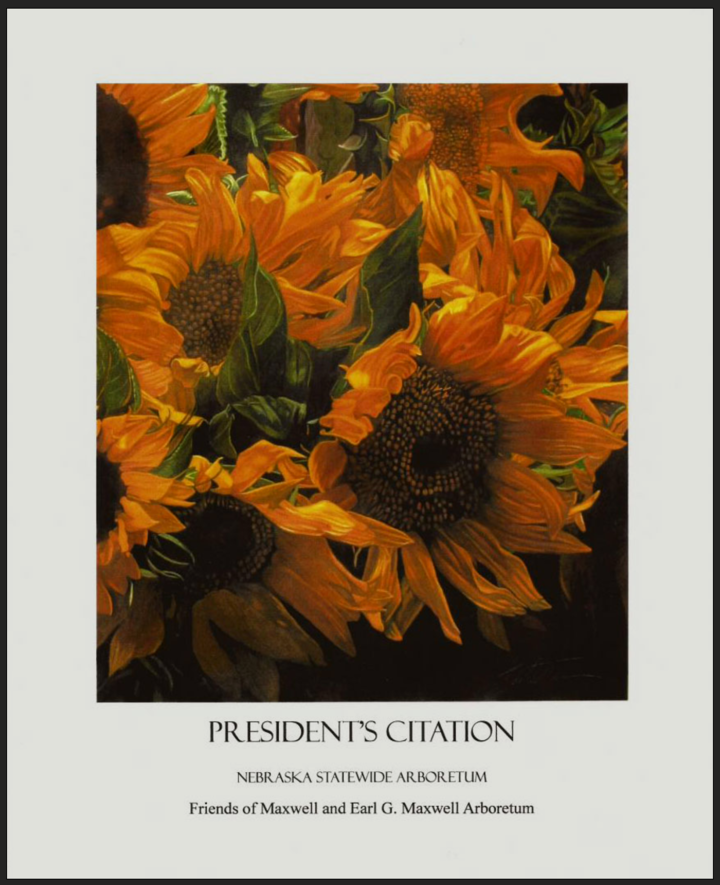
Department of Agronomy and Horticulture Gardens
Evasco Garden
Mission:
To allow learners to experience the beauty and diversity of the plant kingdom in a well-designed and managed, hands on, inspiring, and aesthetic demonstration and teaching garden.
Green industry job opportunities for University of Nebraska–Lincoln horticulture graduates continue to exceed the number of students, reflecting the program's excellence and the industry's growth. Employers value the hands-on experience students gain through comprehensive training in landscape design, management, and plant materials.
The Ruth Willsie Evasco Demonstration and Teaching Garden is a cornerstone of this education. Located centrally on East Campus near Maxwell Arboretum and the teaching greenhouses, the garden supports a variety of undergraduate and graduate courses, including landscape design, management, construction, plant materials identification, floriculture, and horticulture business. Its diverse plantings and thoughtfully designed spaces showcase the art and science of horticulture while adapting to seasonal changes.
The garden also serves as a trial site for new plantings and research, a resource for Extension education programs like Master Gardener training and 4-H classes, and a destination for visitors exploring the campus. Its master plan, originally developed by senior landscape design students, continues to guide improvements, including seating areas, event spaces, and updated plantings.
By offering hands-on learning through classroom assignments, student internships, and community outreach, the Evasco Garden remains an essential element of horticulture education at UNL, fostering lifelong learning and industry engagement.
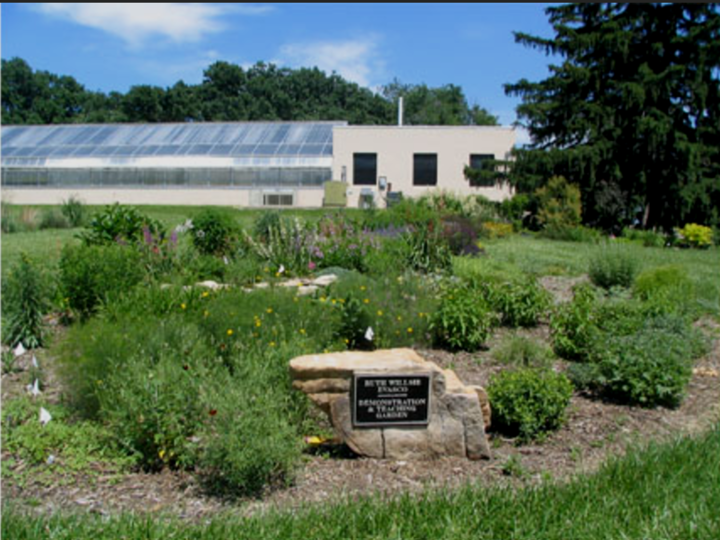
Crops Garden
The crops garden on the East Campus of UNL is our outdoor classroom for courses that include Plant Science, Plant Science lab, and Exploring Plant Biology. The goal is to provide diversity and comparisons for hands on learning. Diversity in our garden is apparent in both what we plant and how we manage the garden. While we focus on Nebraska crops, we include crop species that are grown in other parts of the world. We plant our crops at different times during the summer to provide growth stage comparisons. Finally, we can diversify our weed and insect control to demonstrate how the plants respond to pests and competition.
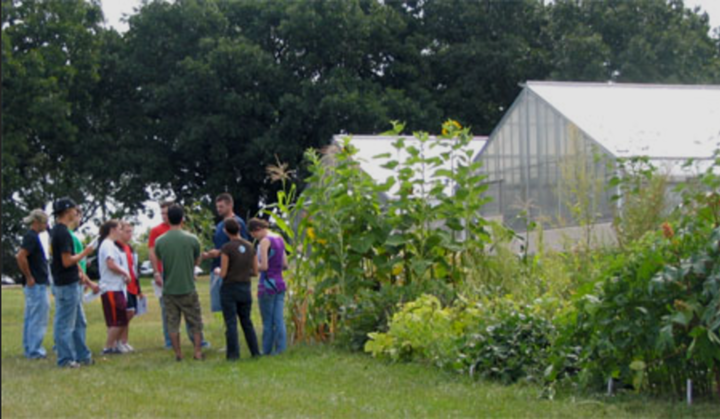
growth in introductory Agronomy and Horticulture courses
Keim Courtyard
The Keim Hall Courtyard project was undertaken in conjunction with the remodeling of the building. The enclosed space, formed by Plant Sciences Hall and Keim Hall, has been transformed into a gathering place for departmental events, a greenspace for having lunch or studying, and an outdoor classroom where students get hands-on experience with landscape construction and management as well as plant identification.
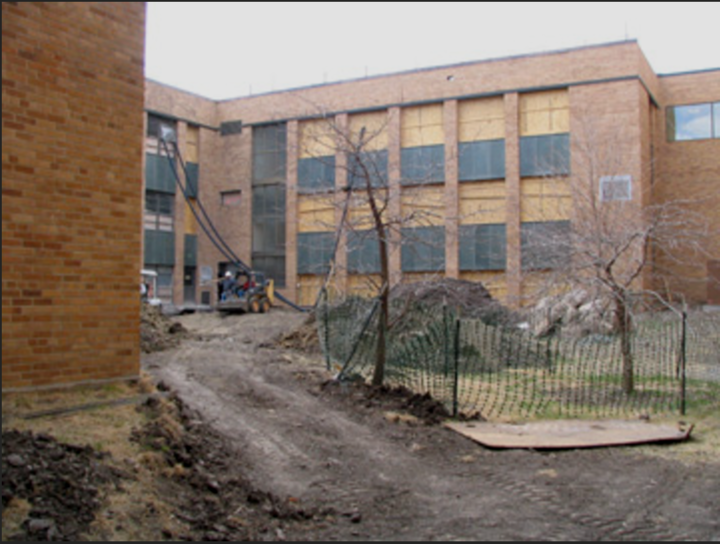
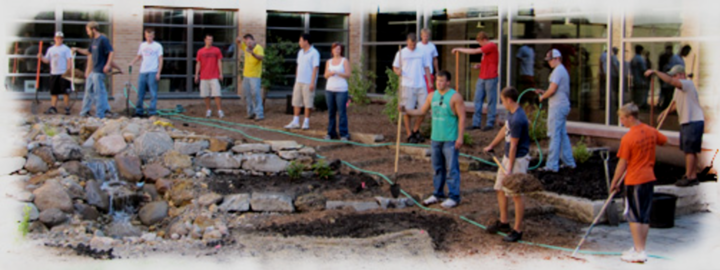

Keim Hall East--Woody Plants
Bibliographic Database of Great Plains Plant Resources
A curated collection of written resources highlights the rich history of horticulture and botany in the Great Plains, with a special emphasis on Nebraska and the University of Nebraska. It features historical works, including 19th- and early 20th-century publications by the university's botanists, horticulturists, and plant scientists, with particular attention to native plants.
Great Plains Plant Resources pdf
A Note About the Annual Reports of the Nebraska State Board of Horticulture:
Among the most valuable yet lesser-known publications in Nebraska's horticultural history are the annual reports of the State Board of Horticulture. These reports are not only rich with information on specific horticultural topics—such as fruits and orchards, trees and shrubs, herbaceous perennials, insect pests, and landscape design—but also provide a fascinating glimpse into the early days of gardening in the state.
Innovations we consider modern, such as the use of native species, are well-documented in these pages. These reports highlight the contributions of key figures who shaped botany and horticulture in Nebraska, including Charles Bessey; Fred Card and R.A. Emerson of the Horticulture Department; W.H. Dunman, the university's landscape gardener; and many others. Additionally, they offer insights into the landscape history of the University of Nebraska's East Campus.
Literature & Landscape History
On the Bookshelf
Horticultural Highlights
Lilacs: A Gardener's Encyclopedia
By Father John L. Fiala, revised and updated by Freek Vrugtman (2008)
This definitive guide to lilacs provides a detailed look at their taxonomy, history, and cultivation. Originally published in 1988, this expanded edition includes insights into hybridization, Eastern European cultivars, and lilacs in art and design. With over 500 stunning photographs, it serves as an essential resource for gardeners, botanists, and lilac enthusiasts alike.
The American Chestnut: The Life, Death, and Rebirth of a Perfect Tree
By Susan Freinkel (2007)
Freinkel explores the ecological and cultural significance of the American chestnut, its tragic decline due to blight, and the ongoing efforts to restore this "perfect tree." Her blend of science and storytelling captures the profound loss felt by Appalachian communities and the hope for its revival through modern breeding programs.
Mighty Giants: An American Chestnut Anthology
Edited by Chris Bolgiano (2007)
This beautifully illustrated anthology celebrates the legacy of the American chestnut with historical and contemporary essays, poetry, art, and scientific insights. Published in collaboration with The American Chestnut Foundation, the book honors the chestnut’s role in American history and highlights ongoing restoration efforts.
The Native Trees of Canada
By Leanne Shapton (2010)
Inspired by a 1917 government publication, Shapton reimagines The Native Trees of Canada with bold, abstract art paired with literary quotes from Canadian authors. Her vivid reinterpretation breathes new life into a technical manual, celebrating the cultural and ecological importance of Canada’s trees. Praised for its creativity, the book has drawn attention both in Canada and internationally.
Articles
Weather and Gardening in Nebraska
Originally published in The Garden News, November 2000
Gardening in Lincoln means embracing extreme weather. With record lows of -33°F and highs of 115°F, temperatures can swing 30-40 degrees in a single day. Precipitation is equally unpredictable—some years bring over 40 inches of rain, while others struggle with just 14. Thunderstorms, tornadoes, blizzards, and droughts all shape the gardener’s experience.
Despite the challenges, Nebraska's changing seasons offer a unique rhythm. From sudden spring thaws to lingering autumns, gardeners adapt with resilient native plants, xeriscaping, and careful watering practices. In drought years, they sacrifice some plants and plan for hardier replacements, always looking forward to next year’s potential.
For insights into Nebraska weather, visit:
Lincoln Weather
High Plains Regional Climate Center
September in the Perennial Garden
Mid-September brings a transitional period—summer fades, but fall hasn’t fully arrived. Temperatures can range from 45°F to 85°F, and gardens often look tired. However, with the right plants, your garden can still shine with late-season vibrancy.
At Maxwell Arboretum’s Yeutter Garden and Fleming Slope, late bloomers steal the show:
- Japanese Anemone (Anemone ×hybrida): A shade-tolerant beauty with tall, semi-double white blooms (‘Whirlwind’) lasting through mid-October.
- Plumbago (Ceratostigma plumbaginoides): Thrives in sun or shade with blue flowers and red autumn foliage.
- Blue Mist Spirea (Caryopteris ×clandonensis): A long-flowering "sub shrub" with late-summer to fall blooms.
- Turtlehead (Chelone lyonii): Deep green foliage and unique pink blossoms, including the cultivar ‘Hot Lips.’
Other late-season highlights include:
- False Sunflower (Heliopsis helianthoides ‘Summer Sun’)
- Sneezeweed (Helenium autumnale ‘Rotgold’)
- Goldenrod (Solidago ‘Crown of Rays,’ ‘Golden Baby’)
- Hardy Crapemyrtle (Lagerstroemia Fleming Filligrees)
- Sedum (‘Autumn Joy’)
- Boltonia (Boltonia asteroides ‘Snowbank’)
For added interest, let seedheads form on your perennials and incorporate native grasses for color, texture, and movement in your garden. Maxwell Arboretum offers inspiration and plant ideas to carry your garden gracefully into fall.
Winter in the Landscape
Winter is an often-overlooked season in gardening, yet it offers unique beauty through texture, form, and contrast. Maxwell Arboretum showcases these features with evergreens, ornamental grasses, textured bark, seedheads, and even winter blooms.
Key Highlights
- Evergreens: Provide structure, texture, and shades of green while acting as natural screens. Examples include Norway Spruce and White Pine.
- Grasses: Add movement and patterns, such as Miscanthus sinensis and Little Bluestem.
- Bark: The intricate textures of trees like Three-Flower Maple and Lacebark Pine are especially striking in winter.
- Seedheads and Fruit: Persistent features, such as Echinacea and crabapples, attract wildlife and add visual interest.
- Winter Blooms: Early bloomers like Snowdrops, Witchhazels, and Lenten Rose offer a touch of life during the cold months.
Explore Maxwell Arboretum this winter for inspiration and ideas to enhance your own garden with seasonal charm.
Tales From Across the Pond: Hawthorn and Holly
By Carol Speth
Hawthorn
North of the gazebo in Maxwell Arboretum stands a Cockspur Hawthorn (Crataegus crus-galli), an American cousin to the Hawthorns of Britain. In the Old Country, Hawthorns were planted as hedges, much like hedge apples in Nebraska. Revered in Celtic lore as a sacred "Fairy Tree," the Hawthorn is also steeped in legend, including the famous Glastonbury Thorn of England.
The Glastonbury Thorn, said to have grown from the staff of Joseph of Arimathea, uniquely blooms twice a year—once in May and once at Christmas. Cuttings grafted onto native rootstock perpetuate this trait, and even today, descendants of the original tree are cherished. Whether you believe the legend or not, the enduring care for this non-native tree is a small miracle of its own.
Holly
Holly has long been associated with the Winter Solstice, predating Christmas traditions. In Celtic mythology, the Holly King ruled from the Summer Solstice to Winter, yielding to the Oak King as days grew longer. Its sharp leaves were believed to ward off evil and offer fairies shelter during winter.
Early Christians adopted holly's symbolism, likening its sharp leaves to Christ's crown of thorns and its red berries to His blood. Whether for its cheerful winter presence or supposed protective powers, holly remains a beloved addition to the landscape.
Maxwell Arboretum features several holly specimens, including one near The Porch on East Campus and another north of the Biochemistry Building, showcasing its shiny leaves and vibrant berries—even on cloudy December days.
The Garden in Winter Bibliography
Allen, Oliver E. Winter Gardens.
Alexandria, VA: Time-Life Books, 1979
CYT: SB439.5 A39
Bales, Suzy The Garden in Winter: Plant for Beauty and Interest in the Quiet Season.
New York: Rodale, 2007
Bloom, Adrian Winter Garden Glory: How to Get the Best From Your Garden From Autumn Through to Spring.
Harper Collins, 1994
Bourne, Val The Winter Garden: Create a Garden That Shines Through the Forgotten Season.
Cassell Illustrated, 2006
Bowles, E.A. My Garden in Autumn and Winter.
Portland, OR: Timber Press, 2003 (1998) (T.C. & E.C. Jack, 1915)
Buchanan, Rita Taylor's Weekend Gardening Guide to the Winter Garden:
Plants That Offer Color and Beauty in Every Season of the Year.
NY: Houghton Mifflin Harcourt, 1997
Eddison, Sydney The Unsung Season: Gardens and Gardeners in Winter.
Houghton Mifflin, 1995
Fish, D.S. The Book of the Winter Garden.
London: John Lane
CYT SB454 F5
Glasener, Erica The Winter Garden
Plants and Gardens, Brooklyn Botanic Garden Record, vol. 47:4, winter 1991
Haes, E.C.M. Winter Color in the Garden.
Garden Book Club, 1965
Kam, Barbara Prairie Winterscape: Creative Gardening for the Forgotten Season.
Fifth House Books, 2003
Noel Kingsbury Seedheads in the Garden.
Portland, Oregan: Timber Press, 2006.
Pearson, Robert The Winter Garden. A Wisley Handbook.
Casswell, 1994
Price, Eluned The Winter Garden: Structure, Planting and Romance in the Garden in WInter.
Smithmark Publishers, 1996
Rosenfeld, Richard The Winter Garden.
Lorenz Books, 2002
Simeone, Vincent A. Wonders of the Winter Landscape: Shrubs and Trees to Brighten the Cold-Weather Season.
Ball Publishing, 2005
Sterndale-Bennett, Jane The Horticulture Gardener's Guides-The Winter Garden.
Cincinnati, OH: Horticulture Books, 2006
Thomas, Graham Stuart Colour in the Winter Garden.
London: J.M. Dent & Sons, Ltd., 1984 (1957)
CYT SB439.5 T56
Verey, Rosemary The Garden in Winter.
Portland, OR: Timber Press, 1995
CYT SB439.5 V47
Wilson, Helen Van Pelt Color For Your Winter Yard and Garden with Flowers, Berries, Birds, and Trees.
NY: Charles Scribner's Sons, 1978
CYT SB439.5 W54
The Horticultural Legacy
The Horticultural Legacy of UNL's East Campus
Since its beginnings as the College Farm, UNL's East Campus has served as a site for horticultural display and experimentation, blending aesthetics with education. Over the decades, several individuals—some renowned, others less so—played pivotal roles in shaping its landscape. While these early efforts were largely driven by men, women began making significant contributions starting in the late 1970s.
The Early Days: Academics and the Landscape
From the 1880s into the early 20th century, landscaping responsibilities fell to faculty members in botany, horticulture, and forestry. Working alongside the Farm Superintendent and, later, a campus gardener, these professors laid the groundwork for East Campus’s horticultural development.
- Charles E. Bessey: Appointed in 1885 as Professor of Botany and Horticulture, Bessey transformed the study of botany at the university. Passionate about Nebraska’s native vegetation, he established a botanical garden and proposed an arboretum shortly after his arrival.
- R.A. Emerson: A horticulture professor and former student of Bessey, Emerson worked to fulfill his mentor’s dream of an arboretum featuring native Nebraska plants and trialed other species for the state. Although the original arboretum no longer stands, remnants can still be found west of Agriculture Hall. Emerson left for Cornell University in 1914, where he mentored George Beadle, a future Nobel Prize winner in genetics.
Contributions Beyond the Faculty
Two non-academic figures made lasting impacts on East Campus’s development:
- S.W. Perin: Hired in 1889 as Campus Superintendent, Perin oversaw nearly every aspect of the farm’s physical environment during his 30-year tenure. His devotion to East Campus was honored upon his death in 1930 when classes were canceled, offices closed, and the flag flown at half-staff. Today, his legacy is commemorated by a replica of his front porch, restored with help from the UNL Garden Friends.
- W.H. Dunman: A native of England and former gardener at Sandringham, the Norfolk estate of King Edward VII, Dunman brought expertise in English border gardening to Nebraska. Hired as Farm Campus Gardener in 1909, he designed the formal beds on the Old Mall and contributed to both East and City Campuses. His friendship with Perin was evident; during Perin’s final illness, Dunman visited daily to assist his longtime colleague.
A Lasting Passion
These early contributors shared a passion for plants that has shaped the horticultural identity of East Campus. Their work remains a source of inspiration and education
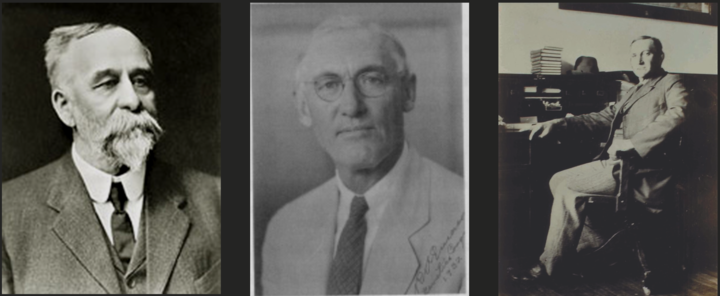
S.W. Perin Journal Entries
Excerpts from the journals of S.W. Perin, Superintendent of the College Farm
Volume 1, 1893
January 1: I got a new saw, two chisels, one 1/2 inch bit and hatchet and padlock for tool chest
I got one board 11x1x18 at Oberlies to make some signs to put up around the Farm forbidding
shooting or trespass of any kind.
[bills for lumber for floor and wainscoating in frame house]
January 7: took farm bell to get fixed
January 10: I went to town on the car
I went to the Horticulture [Society] meeting P.M. There was a good attendance for the first day.
January 12: The Stone House caught fire where the stove pipe goes through the floor. John saw it just
in time as five minutes more would not of saved it, it being very dry.
I was at the Hort meeting all day. Had a good attendance and heard some good papers, one by
J. Sterling Morton on the early Nebraska Horticulture and one by L.A. Stilson on the
Relationship of Bee-Keeping to Horticulture.
April 1: Farm House began work
April 6: The _______ trees are _________and in bloom and leaves are starting on the crab trees in
the Orchard. All small fruit is starting nicely.
April [who's doing what work in which field, what animal is being bred to what animal, work in
orchard, trimming trees]
April 24: [reference to catalpa grave]
May 5: —¦the hard maples in field 9
Went to the University [City Campus] and got some plants 7 trees to set out at Farm
May 9: The rain done so much good everything looks fresh and lively.
May 25: Prairie Rosebud dropped Heifer calf. A very fine looking calf.
May 28: The chancellor, Mr. Morrill [Marnell?], Mr. Dales, Prof. Ingersall came out to look at the
Farm & pick a building spot for the New Laboratory Building. They did not like the looks of
the Horticulture parts of the farm though[t?] I worked hard.
May 29: They started on the new building
June 6: —¦east of catalpas
June 12: [mentions flowers at the Farm]
July 13-14: trimmed hedge [Osage Orange]
October 2: Joe marked on the road east of house in the draw. Mrs. Perin started for the World's Fair
at 2,20.
October 3: [mentions Prof. Card, horticulturist]
Volume 7, 1899 [hourly temperatures in the page margins]
Endpapers: plan of Farm fields
April 15: The colts ran away with the disc brake set. They got scared.
June 17: chancellor and family were out at 8PM
June 20: Mr. Elsworth was out to stake out the ground for New Building [Experiment Station]
June 22: Chancellor & regents Farrell & Kanower & Mr. Elsworth. They came out to look at the
location of the New Building. It will be just back of the corn crib. The corn crib and machine
shed will be moved.
July: Professor Burnette [sic] was out with Prof. Lyman
August 11: Mr. Ellsworth was out & staked out the Building
August14 —¦cut down apple trees that had to be removed on account of New Building
August 21: The men started to excavate for the New Building.
They worked six teams. Mr. Elsworth was out & Mr. _______was out & _______grade stakes
for both buildings.
August 22: The men worked 8 teams at the new building.
August 23: —¦hauled some trees away from the ground where the new building is
August 24: Began hauling brick for new building
August 25: There were 4 teams hauling brick part of the day & one hauling sand. The men got the
ditches almost finished for the concrete.
August 28: they raised the crib and put rollers under it
August 29: Mr. Magee started to move the crib
August 30: Mr. Magee got the crib set in place. They are working ______on the building.
August 31: They had a ________gang working at the New Building
September 1: I got me a new hat. $1,50.
September 3: I finished reading The Prairie by J Fennimore Cooper. It is one of the best of the series &
The Pathfinder dies in this camp of the Pawnees. A splendid character all through the series.
September 5: Men to lay brick on the large building
I fixed the windmill.
September 6: I went to the show with Edna [daughter]. Ringling Bros. It was very good. The trapeze or
Bar performing was very good. & The Elephants were splendid 15 of them 5 in each ring.
September: They ________ to put the foundation under the corn crib.
September 12: The men put the walls of the new building up to water level. Commenced to tar the
outside. Bricklayers waiting for staging to walk on.
September 18: They began to lay brick above the grade line today on east side to the top of the windows.
[Well in boiler house—through very hard red sand into white sand]
October 5: the men layed brick on the cellar wall today
October 14: The men were marking on the arch over the main entrance to the new building. It will be
very pretty.
October 16: The men put keystone caps on the east windows of the new building
October 18: The men finished the south wall of the new building to the top of the windows and worked
on north wall above the windows.
October 19: The men put keystones up at south end of the building & worked on the inside walls.
October: —¦worked on west wall of the Experiment Station building. Got the keystone 99 in the w.y. (?) up
October 21: The men put up the stone over the arch with Expt Station. Finished the wall up to the top 1st
story.
October : They began to lay brick on the second story today of the new building.
November 6: They worked on the upper story of the main building laying brick. They began to plaster
the main building on north end first floor
November 8: They got the main building up to 5 ft all around 2nd story
November 9: The men got the east wall of the main building t the top of the windows with part of arch
over the windows.
November 10: —¦and got to the north end & most of the south end of the main building up to top of
windows.
November 11: They have the n.e. corner of wall to the main building within 3 or 4 brick of the top.
November 13: The ________began to grade around the boiler house and Main Building.
November 14: finished the well in the boiler house. 226 ft from ground level.
November 15: the men put the stairs in the boiler house.
They have the main building up to ______ line on the ends and east side.
November 17: McElery started to dig out for building foundation ________work for animal husbandry
dept. They got the wall of Main Building up to level ready for the upper _______, they put up
some fence & got the derrick set up on top
November 18: They got the ________ on the east side of the main building on top floor & most of the
partition walls up & men were painting on the Boiler House.
November 23: The men worked on the main building. K__meyer began working on the steam pipes.
Sullivan commenced to dig on the trench where the gas pipe runs into the Dairy Building.
November 25: The men built one chimney & started the other.
November 27: They finished the chimneys on the Main Building & are putting up the roof.
December 2: They finished sheeting the main building.
At this point Perin goes on a trip to Sargent, Nebraska and the workman making entries in the daybook no longer records progress on the building.
Notes for March and April 1899:
March
10 First Robbins [sic], A beautiful day. Alfalfa starting.
11 The worst blizzard of the Winter. Not very cold.
14 A wet A.M. .05 of Rain, very muddy P.M. colder at 5P.M. W.N.W.
15 A small blizzard, continued cold
20 Cold. All ground frozen that has thawed.
23 Meadow Larks & Robbins singing
24 Warmer. Very much like spring.
26 Cold. Light snow last night.
29 Cloudy—cold. Wind N.E. No spring yet.
April 1 Cold wind N.W. Halo 4 to 6 P.M.
2 Snow 4 to 8 A.M. 1/2 to 3/4 inch Precipitation .08
3 Sleet A.M. Cold all day.
5 Rain most all day. Sowing clover field 7. Alfalfa
6 Snow last night cold to day
11 Harrowing, maple trees blooming. Elm. Lilac Budding. Sow two _______. Sowing oats.
12 Sowing oats in farm field 6
14 Sowing Alfalfa seed field 8. Oats field 3
15 Sowing " "
17 " Oats field 3
18 " " 3 & field 3 North
20 &21 Oats in 7 Pasture Grass plant in 1 & Oats in fields 13 & Oats & Peas [?] in 13. Wheat & Barley
plant in 6
23 Cottonwood in blossom.
24 Elms, Boxelder [sic], Willows leaving out.
26 Shrubs & fruit trees starting out. Sowing grass seed.
27 Plum trees in Bloom
